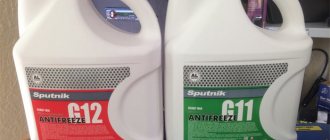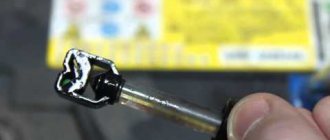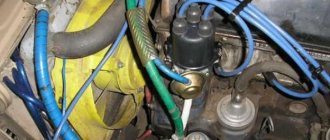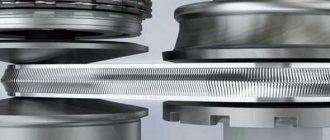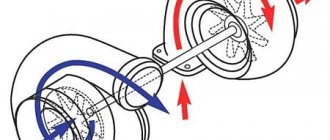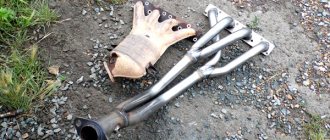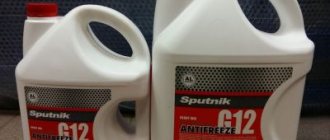Today we will talk about antifreeze, which is the coolant for your car engine. There are many types of liquid on the market, but today we will talk about the two most popular in Russia - red and green. We will tell you which antifreeze is better, as well as how they differ.
Is there a difference
High-quality modern antifreezes are made on the basis of ethylene glycol. This substance provides resistance to freezing at temperatures down to –40 °C. The share of ethylene glycol in antifreeze is approximately 80–90%. This is the main similarity, but what is the difference between red antifreeze and green. The main difference lies in the 5–10% share of additives that are added to the composition to improve its performance. The exact formula of the additive composition is usually unknown, as it is a trade secret. But by the color of the liquid, the consumer can determine the group of excipients that were added to the ethylene glycol solution. Therefore, it is important to understand the differences between green and red antifreeze, as these are the most popular products in their niche.
The most common types of antifreeze are made from ethylene glycol and propylene glycol. Most often they are painted green and red. But to be fair, it should be noted that color cannot be considered a reliable indicator. Nobody regulates manufacturers in this matter, but they try to adhere to the “rules of the game” that have developed in recent years. However, the color of the refrigerant cannot objectively reflect the properties of the composition, since it may contain a variety of additive compositions. Which is better to choose antifreeze - green or red? How might they be different? You will find answers to these questions for yourself below.
We must immediately make a reservation that we will compare certified products from reliable manufacturers. There are a large number of counterfeit products on the market, but the real properties of such products are often unknown even to the underground manufacturers themselves.
It is important to know
It is worth noting that when purchasing a new car, it is necessary to fill in antifreeze clearly knowing the composition of the cooling system. And when purchasing a used car:
- You need to know what type of fluid was used. If this is unknown, it is advised to completely drain the substance, flush the radiator, and then fill in a new one.
- It is worth changing all technical fluids.
- You need to add a red or green substance of the exact brand that has already been used by the driver. Different manufacturers may add different additives, which, when mixed, give an undesirable effect, may foam or deteriorate their cooling properties.
- No matter how long the coolant lasts, it is worth checking its level regularly and replacing it on time.
Green antifreeze: characteristic features
It is this color that the coolant of the conventional but generally accepted class G11 is painted in. Its composition includes additives created on an inorganic or silicate basis. The action of such a complex is as follows. As the solution passes through the pipeline, a thin silicate layer is formed on its walls, protecting against corrosion. As a result, all contacting surfaces do not suffer from oxidation.
Real disadvantages
But there is another side to the coin. The silicate layer is formed from solid silicon particles. Due to vibration and time, they can partially peel off and accumulate in the lower part of the radiator. In addition, the thermal conductivity of silicate anti-corrosion protection is much lower than that of metal. Consequently, such a protective layer reduces the productivity of the cooling system.
Alternative markings
Depending on the manufacturer, green silicate antifreeze may have the following marks on the container:
- Conventional coolants.
- Traditional coolants.
- IAT (Inorganic Acid Technology).
Many experts believe that G11 coolants are well suited for cars with aluminum radiators.
Conclusion
Thus, when choosing between red and green antifreeze, be guided by the recommendations of the car manufacturers and the desired results - if you want to cover the system with a thick protective film, take green, but be prepared that over time such a film reduces heat transfer and crumbles, contaminating the cooling system. If you only want to deal with existing pockets of corrosion, take red, but be prepared that the product will not do anything to prevent the re-formation of corrosion. In addition, be guided by the type of material from which your radiator is made - if one of the colors does not suit it, then you, in fact, will not have a choice.
Red antifreeze: characteristic features
Antifreeze in red shades corresponds to the generally accepted class G12. Its complex of anti-corrosion components is based on carboxylic acid and its special derivatives, which introduces the coolant into the organic category. Red automotive refrigerants are also called carbosilicate antifreezes. During circulation through the cooling system, such a liquid does not form a continuous anti-corrosion protection. Additives are activated directly in places where the oxidation process has begun. During the chemical reaction, the corrosion area is covered with a film several microns thick. The following advantages of red antifreeze can also be highlighted:
- no scale is formed;
- The heat transfer efficiency of the cooling system does not decrease;
- service life reaches 5 years;
- the capacity of highways is not reduced;
- no solid precipitate forms.
Alternative markings
The following symbols can often be seen on containers with red antifreeze:
- Carboxylate coolants.
- OAT (Organic Acid Technology).
It is believed that this group of coolants is more suitable for cars with a copper radiator.
You may be interested in: What antifreezes can be mixed: compatibility table
Purpose of additives
When choosing a coolant, you should know well what the difference is between red, green and blue antifreeze, for example for Renault Duster. All types include water and alcohol, but the additives used vary. They make up approximately 20% of the total mass of the substance. The color depends on them. Such components are needed in order to protect car parts from the harmful effects of alcohol and acid, to extend the life of the coolant, rubber and tubes made of various metal alloys. Additives have not only different properties, but also different costs.
The first generation is antifreeze, it is made using Soviet technology and is suitable for use at temperatures from -50 to +110 degrees. Includes the following additives:
- Nitrites.
- Silicates.
- Borats.
- Phosphates.
Due to the high aggressiveness of antifreeze, it is not suitable for use in modern foreign cars.
More modern liquids include G11. Here the additives are softer, despite the low acid content, they help preserve the aluminum and brass parts of the cooling system, do not corrode the rubber as much, so the radiator lasts longer. Organics allow better heat regulation, create a thicker film, but do not last long. Red G12 contains more organic substances, has an increased service life, more gently protects the system from harmful substances, but is also more expensive.
Is it possible to mix green and red antifreeze?
It may seem that the difference between G11 and G12 refrigerants is insignificant. Indeed, they all have almost 90% identical composition. Moreover, we cannot even say that green or red antifreeze is better. They are simply designed for different cooling systems and operating conditions. But some similarities often become the source of the question of whether the formulations can be mixed.
If we talk about coolants G11 and G12, then you definitely shouldn’t mix them. You will not achieve any savings or improved performance. The chemical composition of organic and inorganic additives is radically different. When mixing them in artisanal conditions, the components may collapse. As a result, you will have to go through an expensive and time-consuming procedure for cleaning the radiator and cooling system lines. Skeptics may say that today you can buy antifreezes of the G12+ and G12++ classes, which combine organic and inorganic additives. But you need to understand that such compositions are produced using complex technology in industrial conditions. Therefore, we can say with confidence that mixing on your own will definitely not give a positive result.
Now you know the difference between green and red antifreeze. There is no universal or best option. Just choose the right coolant - and your car will reward you with stable operation.
#Antifreeze Reviews
Why are they painted?
Why are antifreeze different colors? After all, the various colors of antifreeze are only misleading. It should be said that antifreeze itself is colorless and transparent. And there are three reasons for coloring it:
- Difference from water. Coolant is poisonous, so the main reason is so that it can be distinguished from water and not be drunk by mistake.
- Difference from each other. As a rule, the same brand has a whole line of liquids with different properties. If they were all the same color it would create confusion.
- Finding leaks. What color is antifreeze usually? Whatever it is, it is bright. This is done in order to quickly find leaks. For the same purpose, manufacturers often add a fluorescent dye to the composition, which can be detected under ultraviolet light.
Well, don’t forget about the marketing component. For example, there is a popular opinion that red is the best - so the manufacturer will use this shade.
You may also be interested
SINTEC oils - confidence in the future
Choosing oil for modern equipment is an extremely crucial moment. Units are becoming more and more sophisticated, requirements for lubricants are increasing almost every year, and old formulations can no longer provide reliable protection and trouble-free operation. Stores and service centers offer a huge number of motor and other oils for all types of cars. Most of them are released under [...]
High-quality antifreeze is a guarantee of safe operation of your car
Antifreeze refers to the coolant necessary for the functioning of a car engine. Antifreeze allows you to cool the structural components of a car engine to the required temperature, preventing their deformation and failure. Before the invention of antifreeze, ordinary water was used as a coolant, but the water circulating in the cooling circuit tended to freeze, and when it freezes, the water increases in volume. Water expansion […]
The best manufacturers
Many companies produce antifreeze, but few of them can be called the best. Both imported and Russian manufacturers occupy high positions in the ranking. The following brands stand out among them:
- Tosol-sintez is a Russian manufacturer that produces high-quality products that are in demand among customers.
- Obninskorgsintez - despite its recent appearance on the market, this Russian company can offer an affordable price and high quality.
- Liqui Moly is a German manufacturer, popular in 120 countries around the world.
- Motul is a French company that is very successful. The company's work experience is more than one hundred years.
Life time
Another factor that answers the question “how is red antifreeze different from green.” The first has a service life of up to five years. At the same time, green antifreeze and its domestic analogue “Tosol” can be used in the system for no more than two years.
Then the mixture forms a sediment and begins to contaminate the channels of the cooling system. Checking the condition of the fluid is very simple. It should be oily to the touch and not have any strong odors. Otherwise, the fluid must be replaced, as there is a possibility of engine overheating.
Characteristic
Any antifreeze is designed to remove heat when the engine is running. In winter, this liquid (namely a certain part of it), taking heat from the engine, ensures heating of the interior. In summer, coolant enters the radiator.
In terms of composition, all coolants consist of ethylene glycol. The exception is the 13th group, but more on that later. Foreign antifreezes are a concentrate where the percentage of ethylene glycol reaches 95 percent. Everything else is additives and distilled water. The domestic “Tosol” is designed according to a similar principle, but here the percentage of water content is much higher (up to 40 percent).
Main component
All types of antifreeze contain dihydric alcohols. More often it is ethylene glycol, but recently manufacturers have begun to switch to propylene glycol as a less active, toxic and more modern and environmentally friendly substance. Both alcohols have high boiling points of almost 200 °C, but they freeze already at -11 °C.
Distilled water in the composition helps to overcome this disadvantage, the combination with which gives the usual indicator of -38 °C, and in some ratios -65 °C. This is enough for normal operation of the car in any region of Russia.
You cannot pour ordinary water to cool the system. It boils already at 100 °C, and freezes at 0 °C, leading to breakdowns and ruptures of rubber elements.
About the concentrate
Earlier we mentioned this type of liquid as concentrate. What it is? This product is a kind of semi-finished product. The composition contains everything you need (additives, ethylene glycol) except water. You need to add it yourself. Why isn't this done in production right away? The use of concentrates allows you to reduce the cost of transportation and storage of products. After all, the volume of such a canister is reduced almost threefold. And distilled water can be obtained anywhere. But you won’t be able to save money this way. The price of the concentrate with the condition of purchasing water is the same as in the case of ready-made antifreeze (maximum savings of 2-3 percent).
How to dilute correctly
Now we will tell you a method that will allow you to mix antifreeze as safely as possible if its level has dropped to a minimum. So, our expansion tank is almost empty. Driving with this level of antifreeze is dangerous - the car will not have enough cooling and it will boil. What to do in this case? Since the additive packages in different brands of antifreeze differ, you can restore the coolant level using distilled water.
It is included in any antifreeze (no matter what group it is - G11, 12 or 12+). As practice shows, the properties of a liquid do not change when mixed with water. Manufacturers recommend diluting concentrate using the same principle.
What dangers might await you? The only pitfall is the freezing point of the liquid. Don't use a lot of water. In this case, when cold weather sets in, the coolant may freeze. Antifreeze density is lost. If we talk about specific numbers, for most regions of Russia the figure of 1.04 grams per cubic centimeter is considered critical. In this situation, the liquid freezes at -12 degrees Celsius. To prevent the coolant from freezing at -30, the concentration of distilled water should not exceed 65 percent of the total volume of liquid.
note
When choosing a new antifreeze, take into account the fact that not all companies adhere to the European standard when manufacturing liquids. For example, some Japanese brands produce group 12 antifreeze and color it green.
The service life is up to five years. Also, the color can be crimson, blue, and even yellow. All this is done so that in the event of a breakdown the driver can determine the location of the leak. Therefore, when purchasing, pay special attention not to the color, but to the group to which this or that model belongs. And always use distilled water for topping up.
